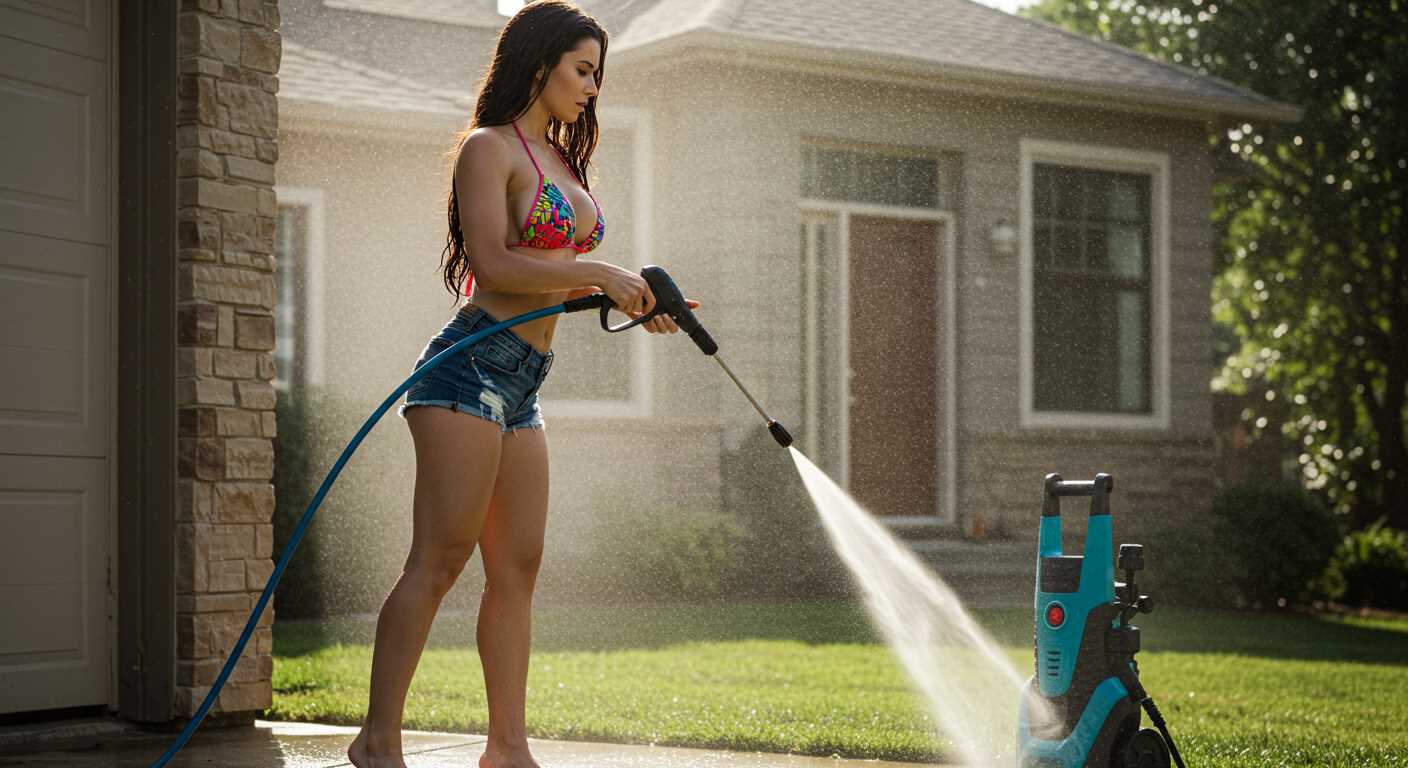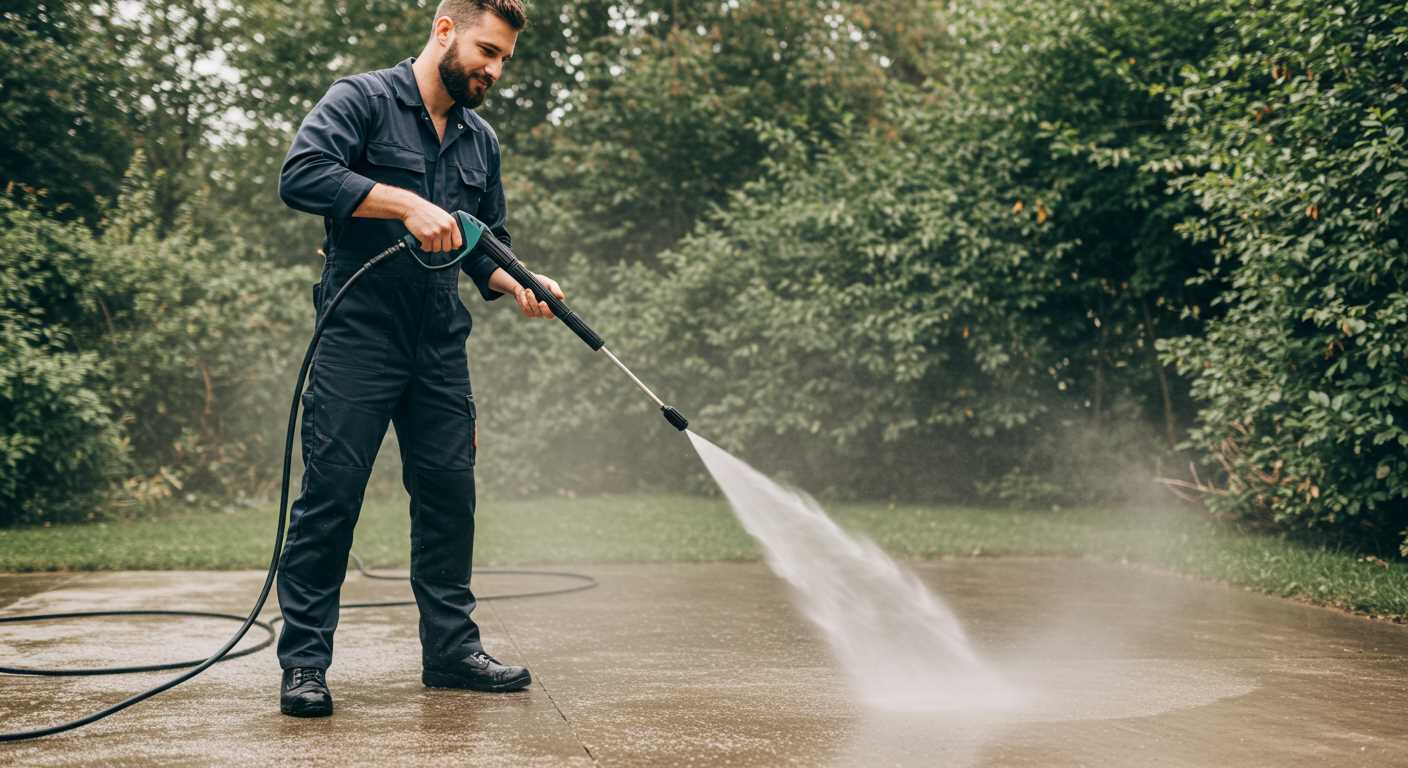



.jpg)
For immediate results, ensure you connect the water supply securely before turning on the machine. A loose connection can lead to leaks that not only waste water but also hinder performance. It’s a simple step that makes a significant difference, especially if you’re tackling a stubborn stain or accumulated grime.
Utilise the correct nozzle for the task at hand. Each attachment serves a specific purpose; for instance, a wide spray is ideal for rinsing large surfaces, while a narrow jet is perfect for removing tough deposits. I remember the first time I tried using an inappropriate nozzle on a heavily soiled patio. What should have been a quick job turned into a frustrating experience. The right choice can save time and effort.
Don’t underestimate the power of cleaning solutions. For grease or oil stains, a degreaser can work wonders in combination with your cleaning device. Apply the solution and let it sit for a few minutes before using the machine to rinse it away. During my time in the industry, I often saw people skip this crucial step, only to be disappointed with their results.
Finally, always maintain your equipment. After each session, ensure you flush the system with clean water to remove any residue. Regular checks on hoses and connections can prevent wear and tear, extending the life of your machine. I’ve learned that a little maintenance goes a long way in preserving performance.
Setting up your nutool pressure washer for first use
Before turning on the device, ensure you have a stable surface for placement. A flat area prevents movement during operation, which can lead to accidents.
Follow these steps for proper assembly:
- Unpack all components from the box and verify against the manual to ensure nothing is missing.
- Attach the handle to the main unit securely. Ensure all screws are tightened to avoid any wobbling.
- Connect the high-pressure hose to the unit, ensuring a snug fit to prevent leaks.
- Attach the spray gun to the other end of the hose. Check for any kinks in the hose that might impede water flow.
Next, prepare the water supply:
- Find a suitable garden hose that is compatible with the inlet of your device.
- Ensure the water source is turned on before connecting the hose to avoid air pockets.
- Connect the hose to the inlet and check for secure fitment.
Now, fill the detergent tank if your model includes one. Use only the recommended cleaning solutions to avoid damage to the internal components. Dilute as per the instructions on the detergent packaging.
Before powering up, check the power source. Ensure it meets the voltage requirements specified in the manual. Plug it into an outlet that is easily accessible, avoiding extension cords if possible for safety reasons.
Once everything is connected and checked, you can turn on the water supply. Press the trigger on the spray gun to release air and ensure a steady flow of water. This step is crucial to avoid sputtering when you first start the machine.
After confirming that everything is secure and functional, you’re ready to power on the device and begin your cleaning tasks. Enjoy the efficiency and results of your new equipment!
Selecting the Right Nozzle for Your Cleaning Task
Choosing the appropriate nozzle can dramatically change your cleaning experience. Each nozzle has a specific purpose, and understanding these differences makes the task more manageable. I recall a time I was tackling an old patio covered in grime. I started with the wrong attachment and saw no results. Switching to a narrow jet nozzle made all the difference, cutting through the dirt effortlessly.
Types of Nozzles
Here are the most common nozzles and their applications:
| Nozzle Type | Angle | Best For |
|---|---|---|
| 0° Nozzle | Red | Heavy-duty cleaning, stubborn stains |
| 15° Nozzle | Yellow | Concrete, brick, and tough surfaces |
| 25° Nozzle | Green | General cleaning, vehicles, decks |
| 40° Nozzle | White | Washing delicate surfaces, siding |
| Soap Nozzle | Black | Applying cleaning solutions |
Tips for Nozzle Selection
When faced with a cleaning task, assess the surface and the level of dirt. For example, for regular maintenance of a wooden deck, I prefer a 25° nozzle, which provides a good mix of power and coverage without causing damage. In contrast, for my patio, I opted for a 15° attachment to tackle built-up grime effectively.
Always start with the widest angle nozzle and increase the pressure as needed. This approach prevents potential surface damage. Remember, a focused stream is powerful but can also be risky on softer materials. Choose wisely, and your cleaning will be both efficient and satisfying.
Connecting and priming the cleaning equipment
Begin by ensuring that the unit is on a stable surface, away from any flammable materials. Securely connect the water supply hose to the inlet, tightening it with your hands to prevent leaks. Do not use tools, as overtightening could damage the fitting.
Next, attach the high-pressure hose to the outlet on the machine. Ensure it clicks into place, and check for any signs of wear or damage before proceeding. A worn hose can lead to dangerous leaks under pressure.
Once the hoses are connected, turn on the water supply. Make sure the water is flowing freely through the hose. This step is crucial; it eliminates air bubbles which can affect performance. Keep the trigger of the gun locked in the off position while doing this.
Now it’s time to prime the device. With the water turned on, pull the trigger on the spray gun to expel any trapped air. You’ll see water flow out of the nozzle, indicating that the system is filled. Hold the trigger until a steady stream of water comes out, usually around 30 seconds. This ensures that the pump is fully primed.
Before starting the motor, check the oil level if applicable. Some models may require this step to ensure proper lubrication. If the oil level is low, add the recommended type to avoid potential damage.
Finally, ensure that the power supply is disconnected while you are setting everything up. Once all connections are secure, and the unit is primed, plug it in and prepare for operation. A careful approach at this stage will lead to a smoother experience while cleaning.
Adjusting pressure settings for different surfaces
Begin with lower settings for delicate surfaces like painted wood or soft plastics. I once made the mistake of using high force on a garden fence, which led to peeling paint and visible damage. Always start at the minimum setting and gradually increase until you find the right balance for effective cleaning without causing harm.
Surface-Specific Recommendations
- Concrete: For driveways and patios, a medium to high setting (around 1500-2000 PSI) is typically effective. I’ve cleaned my driveway with a similar setting, and it removed stubborn stains easily.
- Wood: Use low pressure (500-800 PSI) for decks and furniture. A friend of mine ruined her wooden deck by using too much force, so I always advise caution here.
- Vehicles: For cars, a low to medium setting (around 1200-1500 PSI) is advisable. Ensure you use a suitable nozzle to prevent scratching the paint. I’ve found that using a rotating brush attachment works wonders for dirt removal.
- Glass: Keep it at a very low setting (less than 1000 PSI) when cleaning windows. A colleague once told me about a cracked window from excessive pressure, which I always keep in mind.
Nozzle Selection
Choosing the right nozzle is crucial for adjusting the pressure effectively. A wide spray pattern is better for gentle cleaning, while a narrow pattern increases pressure for tougher jobs. For instance, I always keep a polyurethane pressure washer hose on hand, as it provides flexibility and durability, ensuring consistent performance across various tasks.
Whenever you adjust the pressure, remember to test on a small, inconspicuous area first. This practice has saved me from costly mistakes. If you’re ever considering additional equipment, I recommend looking into the best air compressor for car restoration for those tough jobs that need extra power.
Proper cleaning techniques to avoid damage
Always maintain a distance of at least 12 inches from the surface being cleaned. This prevents excessive force that can strip paint or damage delicate materials. I recall a time when I got too close to a wooden deck and ended up splintering the wood. Lesson learned!
Begin with a low-pressure setting for sensitive surfaces, like vehicles or painted walls. Gradually increase the pressure only if necessary. I once started too high on a car and ended up with a chipped bumper. It’s better to err on the side of caution.
Utilise sweeping motions rather than focusing on one spot for too long. This technique helps distribute the cleaning power evenly and minimises the risk of etching or scarring. I remember a colleague who used a static approach on a patio and ended up with a pattern that looked worse than the original dirt.
Test on a small, inconspicuous area first. I’ve always made it a habit to check how surfaces respond before tackling the entire area. It has saved me from making costly mistakes, especially on textured surfaces.
Always keep the nozzle moving. Staying in one spot too long can cause permanent damage. I once watched a neighbour ruin a beautiful brick wall because they got distracted while cleaning. The result was a patchy finish that required extensive repairs.
Use the appropriate detergent for the job, ensuring it’s compatible with the surfaces you’re cleaning. I once used a harsh cleaner on a composite deck, which led to discoloration. Always read labels and follow instructions carefully.
Lastly, avoid cleaning in direct sunlight. Heat can cause cleaning solutions to dry too quickly, leaving streaks or residue behind. I often choose early mornings or late afternoons for my tasks, and it makes a noticeable difference.
Maintaining Your Equipment After Use
After finishing your cleaning tasks, it’s crucial to give your machine the care it deserves. Start by disconnecting the water supply. This simple step prevents any pressure build-up that could lead to leaks or damage. Next, release any remaining pressure by pulling the trigger on the gun; this ensures all water is expelled from the system.
Cleaning the Filter and Nozzles
Check the water inlet filter regularly. Dirt and debris can clog the filter, reducing efficiency. Remove it gently and rinse under clean water. For nozzles, ensure they are free from blockages. A toothpick can help clear stubborn residues. Regular checks extend the life of your attachments.
Storing Properly
After a thorough clean, store the unit in a dry area, protected from extreme temperatures. If you plan to leave it unused for an extended period, consider draining the system entirely. You can do this by running the machine briefly without water. It’s also wise to coil hoses neatly to prevent kinks and damage.
Lastly, a light application of lubricant on moving parts helps maintain performance. Make it a habit to inspect your equipment regularly; early detection of issues can save you time and money in the long run.

.jpg)




.jpg)


